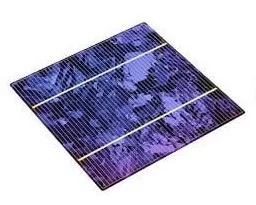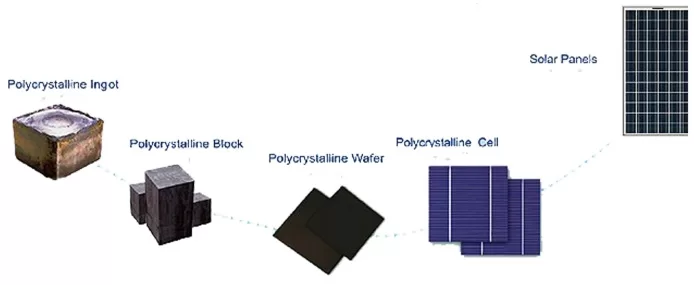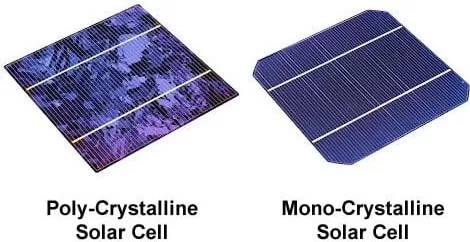Polycrystalline solar panels are a popular and cost-effective alternative to monocrystalline panels. They offer several advantages, including increased efficiency, durability, and reduced costs. We’ll explore everything you need to know about polycrystalline panels, from their composition to their installation and maintenance.
Solar energy is rapidly becoming a popular and cost-effective source of renewable energy. Due to their high efficiency and lower costs, polycrystalline solar panels have become one of the most widely used types of solar panels.We’ll explore the composition, advantages, and disadvantages of polycrystalline panels, and compare them with monocrystalline panels.
What are Polycrystalline Solar Panels?
Unlike monocrystalline solar panels, which consist of a single silicon crystal, polycrystalline solar panels comprise multiple silicon crystals. Manufacturers melt these crystals together to form a solid block of silicon and then cut it into thin wafers to create solar cells. The cells are then connect to each other to form a solar panel.

How are Polycrystalline Solar Panels Made?
Polycrystalline solar panels make using a casting process. Silicon melt in a furnace and then poured into a square mold. Once the silicon cools and solidifies, it is slice into thin wafers using a diamond saw. The wafers are then treated with chemicals to create an electric field on the surface. Metal contacts add to the front and back of each wafer to allow for the flow of electricity.

Advantages of Polycrystalline Solar Panels
Polycrystalline solar panels offer several advantages over other types of solar panels, including:
- Lower costs: These solar panels are cheaper to produce than monocrystalline solar panels, making them a more cost-effective option for homeowners and businesses.
- High efficiency: They have a high efficiency rate, typically around 15-20%, which means they can generate a significant amount of electricity even in low light conditions.
- Durability: Polycrystalline panels are durable and can withstand harsh weather conditions such as hail and snow.
- Easy installation: This type of solar panels are easy to install and can be mounted on most types of roofs.
Disadvantages of Polycrystalline Solar Panels
While polycrystalline solar panels offer several advantages, they also have some disadvantages, including:
- Lower efficiency: Polycrystalline panels have a lower efficiency rate compared to monocrystalline panels. This means they need more space to generate the same amount of electricity as monocrystalline solar panels.
- Reduced lifespan: Polycrystalline solar panels have a slightly shorter lifespan compared to monocrystalline panels, typically around 25 years compared to 30 years for monocrystalline solar panels.
- Appearance: Polycrystalline solar panels have a bluish tint, which some people may find less aesthetically pleasing than the uniform black color of monocrystalline panels.
Efficiency of Polycrystalline Solar Panels
With an efficiency rate of around 15-20%, polycrystalline solar panels have a lower efficiency rate than monocrystalline solar panels, which can reach up to 22%. However, advancements in technology have led to an increase in the efficiency of polycrystalline solar panels in recent years, narrowing the gap between the two types of panels.
Installation of Polycrystalline Solar Panels
Polycrystalline solar panels can install on most types of roofs, including flat, sloped, and metal roofs. They are typically mounted using a racking system that secures the panels to the roof. The racking system is usually made of aluminum or stainless steel and can customize to fit the specific needs of the installation.
Maintenance of Polycrystalline Solar Panels
Polycrystalline solar panels require very little maintenance, but it is important to keep them clean and free from debris to ensure optimal performance. They should clean using a soft cloth and a mild detergent or water, and any accumulated debris should removed to prevent shading of the panels.
Comparison with Monocrystalline Solar Panels
Polycrystalline solar panels offer several advantages over monocrystalline solar panels, including lower costs and increased durability. However, monocrystalline solar panels have a higher efficiency rate and a longer lifespan. Ultimately, the choice between polycrystalline and monocrystalline solar panels will depend on your specific needs and budget.

Conclusion
Polycrystalline solar panels are a cost-effective and efficient alternative to monocrystalline solar panels. They offer several advantages, including lower costs and increased durability, and can easily install on most types of roofs. While they have a lower efficiency rate than monocrystalline solar panels, advancements in technology have narrowed the gap between the two types of panels in recent years.
FAQs
How long do polycrystalline solar panels last?
- Polycrystalline solar panels typically last around 25 years.
Are polycrystalline solar panels more affordable than monocrystalline solar panels?
- Yes, polycrystalline solar panels are typically more affordable than monocrystalline solar panels.
How do I clean my polycrystalline solar panels?
- You should clean your polycrystalline solar panels using a soft cloth and a mild detergent or water.
Can polycrystalline solar panels use on all types of roofs?
- Yes, polycrystalline solar panels can install on most types of roofs, including flat, sloped, and metal roofs.
Which type of solar panel is better, polycrystalline or monocrystalline?
- The choice between polycrystalline and monocrystalline solar panels will depend on your specific needs and budget. Polycrystalline panels offer lower costs and increased durability, while monocrystalline panels have a higher efficiency rate and a longer lifespan.